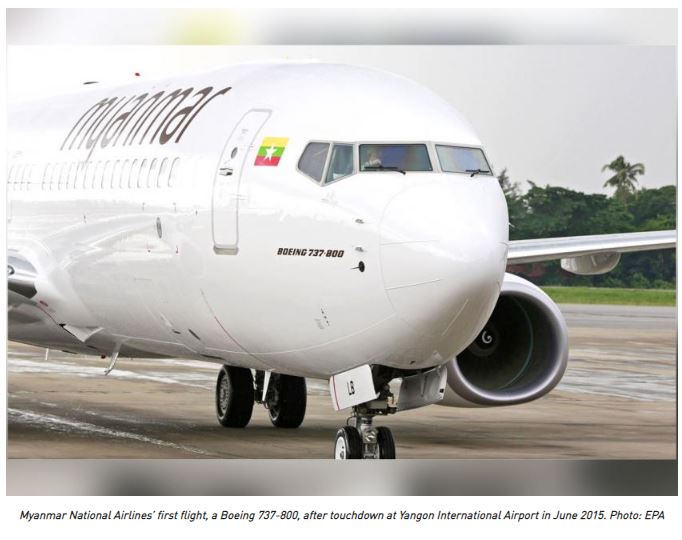Myanmar: Restructuring, cost efficiencies needed to lift MNA out of the red
Despite launching new international routes and enjoying higher passenger load factors, Myanmar National Airlines (MNA) is still in the red.
This is now prompting calls for an overhaul of its cost structure and a plan to upgrade existing infrastructure such as the airline’s payment systems, moves that may well give the airline a second lease of life even as other airlines shutter.
Based on a report by the Pyidaungsu Hluttaw’s Joint Public Accounts Committee, the national airline has been losing money since being corporatised from a purely state-run enterprise five years ago, with losses over the last 3.5 years amounting to K21 billion.
The losses came in spite of growing revenues, which rose 34 percent year-on-year (yoy) to K153.8 billion in 2017-18 and 74pc yoy to K114.9 billion in 2016-17, respectively. This was largely due to MNA flying more routes, including to 27 local and seven foreign destinations.
The Union Auditor General noted in the report that MNA had borrowed heavily to replace its aging Fokker and ATR planes with more modern aircraft. This includes a loan from China’s EXIM Bank amounting to RMB375 million (US$54.336 million) to buy three MA60 planes.
“When we reviewed MNA’s books, we found that its income doesn’t cover operational expenditure. They owe money for purchasing new planes and the interest on the loans was nearly K7 billion in 2016-17 and K11billion in 2017-18,” said U Aung Min, deputy chair of the Joint Public Accounts Committee.
The airline was also weighed down by high maintenance and employee remuneration costs.
U Win Khant, permanent secretary of the Ministry of Transport and Communications, said MNA’s financial woes began almost as soon as it announced international destinations and Boeing aircraft in 2015, beginning with Singapore.
MNA, which was founded in 1948 under the name of Union of Burma Airways, flies to more than 20 destinations in Myanmar.
“Unnecessary risks were taken to corporatise the airline when it was obviously not ready. For one, it had only old planes that were mostly no longer in use around the world and expensive to maintain,” he pointed out.
As it also did not have the funding to develop infrastructure to become competitive, “the airline is struggling even now.”
If there is a budget shortfall, MNA has to struggle to make repayment and has been bailed out by a fund of state-owned Myanma Port Authority, U Win Khant said.
U Aung Min suggested that for the airline to eventually be profitable, it would need to restructure and invest more in staff training. “Unlike other state-owned businesses, MNA wasn’t established with profit in mind. For example, the airline needed to ensure that it covered certain domestic routes despite the fact that these did not make money,” he said.
The Auditor General’s report said better financial management to reduce cost and increase profit, more market-driven services and a more effective campaign to get the public to use the airline were needed.
It said procurement procedures for buying planes should be strengthened and streamlined while funds deposited in banks for the airline’s daily operations should be better managed and in accordance with banking regulations.
The report noted that for MNA to compete on international routes, there must be an overhaul of the ticketing and payment systems, which included modernising these systems and placing them on an IT platform that enables online payments.
But U Than Soe, another member of the Joint Public Accounts Committee, said MNA lacked a systematic policy and strategy as well as clear-cut guidelines to become operationally more effective and profitable.
“There should be a more definite policy where bailouts of state-owned businesses are concerned. The government should be firm on the budget and the businesses should work within the budget. Also, the businesses should take responsibility for their losses,” he said.
U Than Soe added that poor allocation of resources and talent lay at the root of why state-owned businesses failed. “Only experienced people should be appointed to helm such businesses so that such cases would not persist,” he said.
If it undergoes a thorough restructuring, MNA may yet emerge from its current struggles. Indeed, a breakdown of the airlines books showed the airline’s losses had more than halved from almost K9 billion in 2015-16 to K3.4 billion in 2017-18.
What’s more, with the industry shrinking, competition could ease further in the years ahead, allowing MNA to gain some market share. Over the past year alone, three private airlines – Air Mandalay, Air Bagan and Apex Airlines – have ceased operations. Currently, there are just five private airlines operating domestically compared to eight a year ago and 10 three years ago.
Of the remaining airlines in operation, only Air KBZ, the largest, plans to expand capacity this year. – Translated
Source: https://www.mmtimes.com/news/restructuring-cost-efficiencies-needed-lift-mna-out-red.html


 Thailand
Thailand




